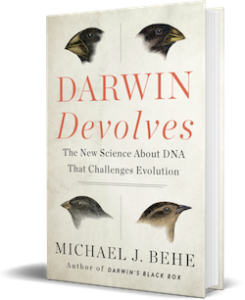 Evolution
Evolution
Important Medical Effects but Modest Mutations


I was asked to address a comment left by a viewer of one of Discovery’s YouTube videos. The comment is:1
Some monkeys have a mutation in a protein called TRIM5 that results in a piece of another, defunct protein being tacked onto TRIM5. The result is a hybrid protein called TRIM5-CypA, which can protect cells from infection with retroviruses such as HIV. Here, a single mutation has resulted in a new protein with a new and potentially vital function. New protein, new function, new information.
A bit of Googling shows that the text was taken word-for-word from an old article (2008) on the New Scientist website2 (perhaps by way of intermediate copying). That was during a period when the 150th anniversary of the publication of the Origin of Species was fast approaching, and many science-y websites were doing all they could to spin whatever information they had to defend Darwin from those crazy ID people. It turns out the results they cite are interesting but quite modest.
A “Restriction Factor”
Trim5 is a “restriction factor” — one of a group of proteins cells have that can prevent or slow infection by a retrovirus such as HIV. CypA is a common, abundant cellular protein that can interconvert proline residues in proteins between their cis– and trans– forms. (If you’re not sure what that means, don’t worry about it — it’s a secondary concern.) It turns out that both Trim5 and CypA can bind specifically to HIV. The binding of CypA interconverts the proline of an HIV protein, so it actually helps the virus. The binding of multiple copies of Trim5, on the other hand, seems to cage the virus before it releases its RNA, preventing it from infecting the cell.
Here’s the trick. It turns out that the binding of CypA prevents the binding of Trim5 (apparently the two proteins compete for the same site on the virus).3 Thus CypA can interfere with the ability of Trim5 to do its job. Worse, CypA seems to bind more strongly than Trim5, shutting it out. In some species of monkey, a new gene was discovered that has a CypA gene fused to the end of a Trim5 gene, so that it makes a single protein that has the two proteins hooked together.4 (The fusion of the genes has also been observed in rodents.5 Such gene fusion can be explained as the result of the rather sloppy reverse-transcribing activity of an HIV protein that can take RNA — occasionally including host cell RNA — make a DNA copy of it, and splice it back into the host’s DNA.) In one monkey species the hybrid protein does a better job of protecting monkey cells against HIV infection. That might be because the CypA-portion binds to the virus and thereby actually delivers Trim5 to where it needs to be to work. Apparently, the fusion of the two proteins doesn’t mess up Trim5’s function.
What Darwinian Processes Can Do
 That’s all fine and, in my opinion, is a good example of what Darwinian processes can indeed do in nature. However, let’s notice a few things. First, the two proteins, Trim5 and CypA, were already present in the monkey ancestor, along with their enzymatic activity and ability to bind HIV. Thus, as I wrote in a review article in the Quarterly Review of Biology in 20106 and reiterated in Darwin Devolves last year,7 this does not represent the gain of what I call a Functional Coded elemenT (FCT) — that is, the gain of a coded sequence that can do something novel, such as a new regulatory region, protein modification site, or many other possibilities. Instead, pre-existing genetic information was shuffled around, which I categorized as a modification-of-function. Modifications (including rearrangements) of pre-existing genetic elements are pretty common in evolution; gain-of-FCTs are much more rare. Yet the big problem to explain, of course, is how functional coded elements are gained, not lost or modified.
That’s all fine and, in my opinion, is a good example of what Darwinian processes can indeed do in nature. However, let’s notice a few things. First, the two proteins, Trim5 and CypA, were already present in the monkey ancestor, along with their enzymatic activity and ability to bind HIV. Thus, as I wrote in a review article in the Quarterly Review of Biology in 20106 and reiterated in Darwin Devolves last year,7 this does not represent the gain of what I call a Functional Coded elemenT (FCT) — that is, the gain of a coded sequence that can do something novel, such as a new regulatory region, protein modification site, or many other possibilities. Instead, pre-existing genetic information was shuffled around, which I categorized as a modification-of-function. Modifications (including rearrangements) of pre-existing genetic elements are pretty common in evolution; gain-of-FCTs are much more rare. Yet the big problem to explain, of course, is how functional coded elements are gained, not lost or modified.
A Possibly Helpful Step
A second thing to notice is that the fusion does not seem to help in some monkey species.8
The block to HIV-1 infection in lymphocytes from animals bearing the TRIM5-CypA allele was weaker than that in cells from wild type animals. … Thus, unlike owl monkey TRIMCyp, expression of the macaque TRIM5-CypA isoform does not result in increased restriction of HIV-1.
Thus it seems to be just a possibly helpful step, contingent on other cellular factors. Third, CypA “has interacted with invading lentiviruses related to HIV-1 for millions of years.”9 In other words, after millions of years of evolution the best that Darwinian processes have done in response to a deadly virus is to shuffle around some pre-existing genes, to modest effect.
It’s important to remember that Darwinian factors are indeed real and can have important medical effects, but they only modify life around the edges. As I show in Darwin Devolves, the most frequent way in which random mutation and natural selection produce beneficial effects, ironically, is by degrading or destroying pre-existing genetic information.
References:
- Meyer, S. 2019. “DNA and Information.”
- LePage, M. 2008. “Evolution myths: Mutations can only destroy information.” New Scientist.
- Selyutina, A. et al. 2019. “Cyclophilin A Prevents HIV-1 Restriction in Lymphocytes by Blocking Human TRIM5α Binding to the viral Core.” bioRxiv:678037.
- Nisole, S. et al. 2004. “A Trim5-cyclophilin A fusion protein found in owl monkey kidney cells can restrict HIV-1.” Proceedings of the National Academy of Sciences of the United States of America 101 (36):13324-13328.
- Boso, G. et al. 2019. “Evolution of the rodent Trim5 cluster is marked by divergent paralogous expansions and independent acquisitions of TrimCyp fusions.” Scientific Reports 9:11263.
- Behe, M. J. 2010. “Experimental Evolution, Loss-of-function Mutations, and ‘The First Rule of Adaptive Evolution’.” Quarterly Review of Biology 85 (4):1-27.
- Behe, M. J. 2019. Darwin Devolves : the New Science about DNA That Challenges Evolution. New York, NY: HarperOne.
- Newman, R. et al. 2008. “Evolution of a TRIM5-CypA splice isoform in old world monkeys.” PLoS Pathogens 4:e1000003-e1000003.
- Kim, K. et al. 2019. “Cyclophilin A protects HIV-1 from restriction by human TRIM5α.” Nature Microbiology 4:2044-2051.
Photo: A rhesus macaque, by Pradeep717 [CC BY-SA].
